Telescope House Sky Guide July Part 2
Deep Sky Delights in Sagittarius, Serpens Cauda and Scutum
This month we visit a very rich area of the heavens: Sagittarius, the eastern part of Serpens (Serpens Cauda - the tail of the serpent) and the compact but notable constellation of Scutum, the Shield.
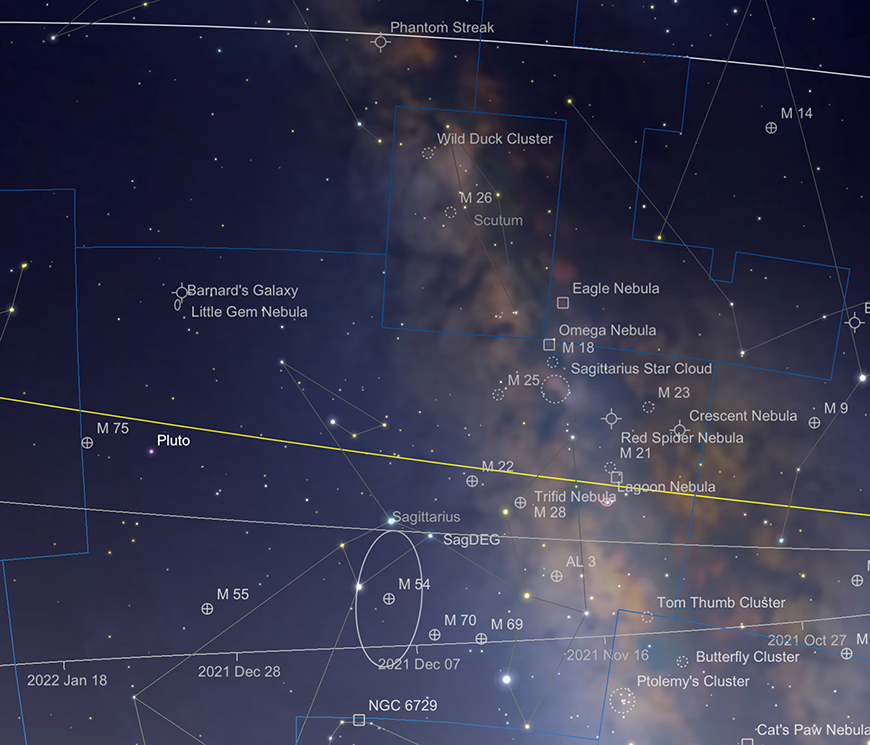
Sagittarius, Serpens Cauda and Scutum. Image created with SkySafari 5 for Mac OS X, ©2010-2016 Simulation Curriculum Corp., .com.
We start in Sagittarius with a chain of globular clusters, which are practically as low as one can observe from UK latitudes - though the further south you find yourself, naturally the better you can see them. Northern temperate observers have to contend with atmospherics in order to make any meaningful observations of these objects - naturally, it almost goes without saying that having a clear southerly horizon is a must! These are difficult objects from the UK, but rewarding to identify.
Messiers 69, 70 and 54 are strung out in a line running between Kaus Australis , Epsilon Sagittarii and Ascella, Zeta Sagittarii, Sagittarius’ first and third brightest stars respectively - the line representing the base of Sagittarius’“Teapot” asterism M69 is the most westerly and is +7.69 mag and 1.7 arc minutes diameter.
It was discovered, along with its neighbour M70 on the same night, August 31st 1780, by Messier. This is within reach of decent binoculars, though begin compact and not especially bright will require a larger telescope to resolve individual stars. The same can be said of M70, to be found 2 1/2 degrees to the east, though it is a little fainter at +7.86 mag and somewhat more compact at 1.4 arc minutes diameter. M54 is found just over three degrees to the NW of M70 and was discovered a little earlier by Messier in 1778. It can be more easily located by working back from Ascella by 1 3/4 degrees to the west. M54 is the brightest of this globular chain at +7.59 and is 1.6 arc minutes in diameter. M54’s appearance is very smooth and uniform and it is very difficult to resolve into individual stars, even in larger instruments. M54 is a bit of a mist in regards to its neighbours, which are both around 29,000 light years away from Earth. In comparison, M54 is around 86,000 light years away and rapidly receding from us. It was discovered in 1994 that M54 is not a member of the Milky Way’s globular family. Instead it is associated with the Sagittarius Dwarf Galaxy, a satellite attendant galaxy of the Milky Way. M54 lies right in the middle of the Sagittarius Dwarf from our perspective - though the galaxy itself is very difficult to detect. Although +4.50 mag, this galaxy is spread out over a huge area of sky - a colossal 447 x 214 arc minutes! This is the reason it remained undetected for so long. M54 is huge and extremely luminous - running a close second to Omega Centauri in terms of size and brightness. It is practically the only globular one can easily observe and say with certainty that it does not belong to our galaxy - so worthwhile looking out for.
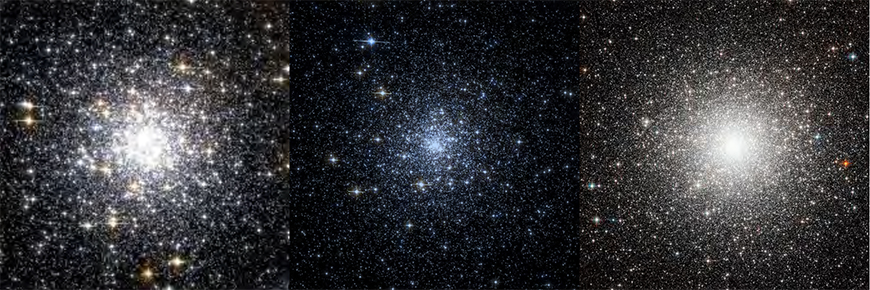
Left to Right: M69, M70, M54. Image credit: Hubble - NASA/ESA. Public domain/creative commons
9 2/3 degrees to the west of M54 lies another globular, M55. M55 is much brighter than the members of the “chain” at +6.32 mag and considerably larger at 5.7 arc minutes across. Reported by Nicholas Louis de Lacaille to Messier, after the former observed it on his 1752 trip to South Africa, Messier recovered it in 1778. At roughly 2/3rds the diameter of the Full Moon, M55 is big. Subsequently, even in binoculars, M55 appears granular and it is very easy to resolve its individual stars in a telescope. At 17-18,000 light years distance it is one of our nearest globular neighbours and a rewarding sight - if you can find it from your particular location. From 51 degrees N, this globular stands a maximum of 7 3/4 degrees high above the horizon at point of transit, so, like all the aforementioned globulars is a challenge to observe.
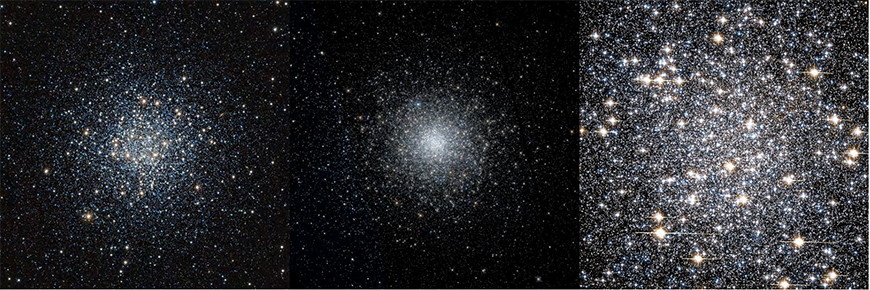
Left to Right: M55, M75, M22. Image credit: ESO, Hubble - NASA/ESA. Public domain/creative commons
11 degrees to the E of M55, lies another Messier globular, M75. Much more compact and fainter then its neighbour, M75 is +8.52 mag and 0.9 arc minutes across and is to be found around 68,000 light years away - on the opposing side of the Milky Way’s core to our part of the galaxy. Although fainter than many globulars, M75’s core is condensed and while you won’t be able to resolve individual stars in binoculars, telescopically at high power, it does reveal granulation. M75 was discovered in August 1780 by Messier’s collaborator, Pierre Mechain and confirmed by Messier a little while afterwards in the same year. Sir William Herschel found it in 1784 and was moved to describe it as a “miniature of M3 [the prominent globular in Canes Venatici] “. Although nowhere near as spectacular as the lovely M3, who are we to disagree with Herschel?
Moving back westwards from M75, past Nunki, Simga Sagittarii, the second brightest star in the constellation (marking the top of the handle of the “Teapot”), we come the jewel of the Sagittarian globulars, the lovely M22. At +5.09 mag, this cluster outshines all the others in its class, bar Omega Centauri and 47 Tucanae. Lying on the plane of the Milky Way means this cluster is probably not as well-de ned and noticeable in its particular location as it would be were it in another, darker part of the sky. However, an observer can still make out M22 from a dark location with the naked eye. Through a telescope or binoculars it is stunning - an elliptical blizzard of stars, easily resolved in all types of optics, though it is true that its core is not particularly well-condensed. At 6.7 arc minutes across, M22 is larger than most globulars, including 47 Tucanae. Only the massive Omega Centauri, at 10 arc minutes across is appreciably bigger.
M22 may have been recorded by Hevelius, but its discovery is normally credited to the 17th century German Astronomer Abraham Ihle, who first reported it in 1665. Halley included it as part of his 6 nebulous objects of 1715. Messier found and cataloged M22 on June 5th 1764.
The reason for M22’s comparative brightness has nothing to do with its physical dimensions - at 97 light years diameter and 210,000 solar masses, it is quite average. M22 is so bright and large because it is close to us as globulars go - around 10,000 light years from Earth.
2 1/2 degrees from M22 to the SW is the star Kaus Borealis, Lambda Sagittarii. This star marks the tip of the “Teapot’s” lid and also provides a useful star hopping point for the next globular Sagittarius has on offer - M28. This globular can be found a little under a degree to the west of Kaus Borealis. M28 is a little less bright and large than its neighbour, but is a lovely object in its own right. At +6.78 and just under 4 arc minutes diameter, M28 lurks on the very limit of human naked eye resolution. By all means attempt to find it without binoculars or telescope, but you will need a very, very dark location and good night adaption in order to make the attempt. However, in binoculars and telescopes, M28 really delivers. More compact and condensed than M22, M28 has a distinct core, surrounded by a halo of looser granular stars. Binoculars will pick up this granularity, but won’t resolve individual stars - a larger telescope (probably 8-inches +) will.
M28 was discovered by messier at some point in July 1764, a month after its neighbour M22. It is now known to lie some 18,000 light years away from us and be around 60 light years in diameter. Again, like M22, M28 is a cluster well worth seeking out.
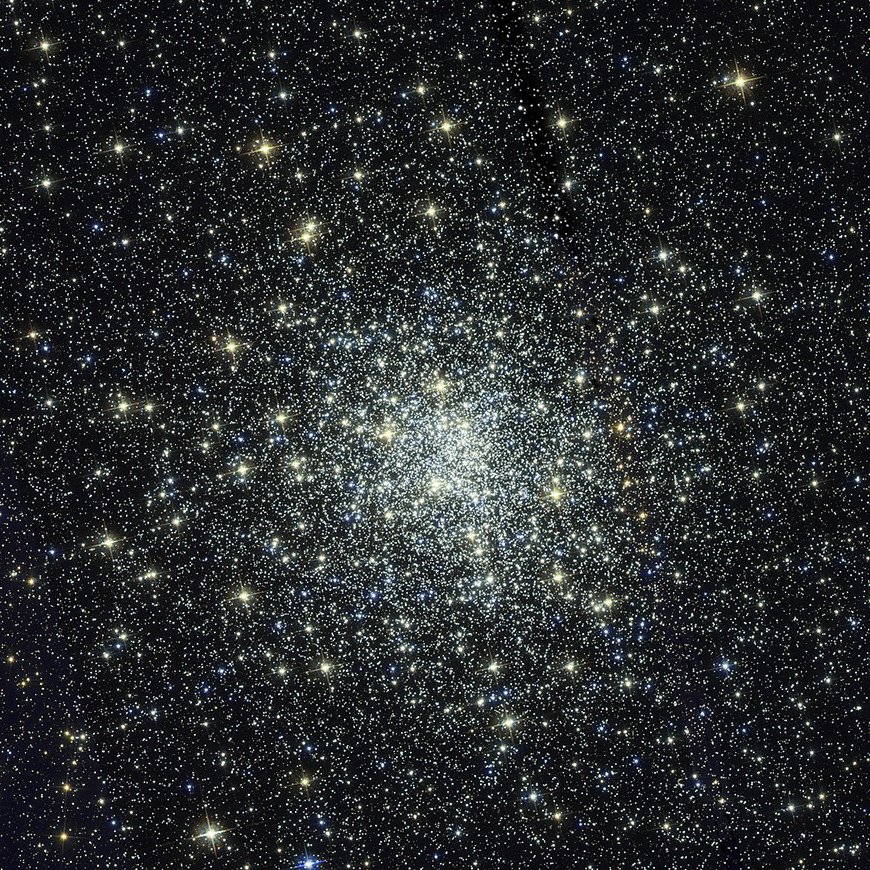
M28. Image credit: Hubble - NASA/ESA. Public domain.
We now take a break from the delights of globular clusters for a little while to explore one of the best parts of the sky for nebulae - the heart of the Sagittarius Milky Way.
Moving westwards from M28, by 4 3/4 degrees, we arrive at the fabulous Lagoon Nebula, M8. At 4300 Light Years distance, the Lagoon appears as a titanic object n our skies. It is a degree and a half in length and over half a degree wide – roughly three full Moon’s width by a Moon’s width – comparable in area to the Orion Nebula M42/M43 complex, though not quite as bright. Still at +6 mag it is an easy object in large binoculars and small telescopes, though at a maximum of 14 1⁄2 degrees above the horizon at its highest for the UK, it can be a tricky object for those without a clear southern horizon. The Lagoon is so prominent, it was first cataloged by the telescopic observer Giovanni Battista Hodierna in or slightly before 1654. It was also noted by English Astronomer Royal John Flamstead around 1680 and French Astronomers de Cheseaux and Le Gentil in 1747 and 1748 respectively. Messier cataloged the Lagoon in 1764, noting both the cluster that lies within the nebula and the nebulosity.
The Lagoon is home to numerous young stars and the Hourglass section of its interior is actively observed to be in the process of stellar formation. It is these stars that cause the nebula to glow its distinctive pink colour, which make the Lagoon another very attractive target for astrophotographers.
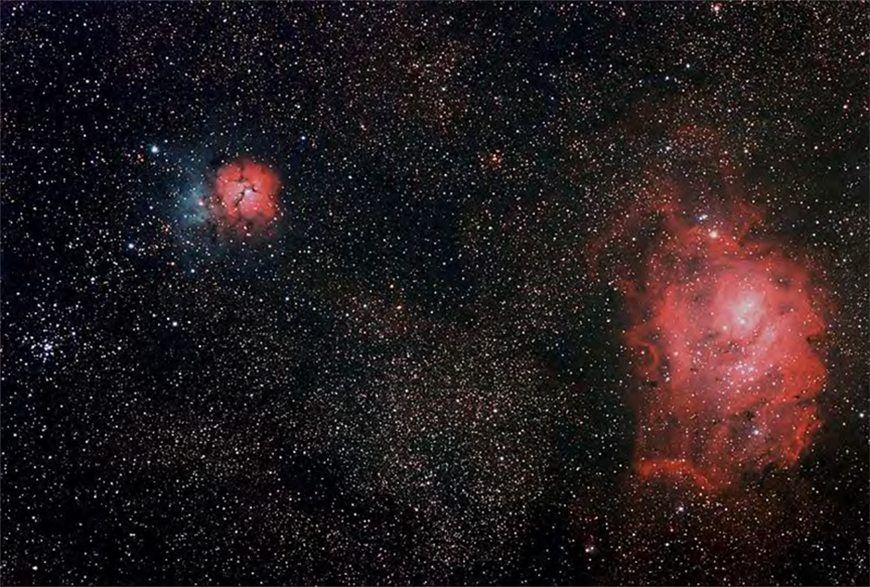
The Trifid Nebula and The Lagoon Nebula. Image Credit: Ljubinko Jovanovic. Creative Commons.
1 1⁄2 degrees north of the Lagoon lies the magnificent Trifid Nebula, or M20. This is one of the best deep sky objects in the sky to observe and can be easily found in binoculars and telescopes. At +6.30 mag and half a degree across, the Trifid is an impressive sight. Progressively larger instruments will show the dark lanes that trisect this object and a UHC filter will also help isolate the lanes and enhance the brighter HII regions. It was the trisecting pattern of dark material that gave rise to the Trifid’s popular name. John Herschel was the first to describe it as such and the name stuck, though it was first discovered by the French observer Le Gentil in 1750 and later cataloged by Charles Messier, if he rediscovered it on June 5th 1764. Located around 5000 Light Years from us, the Trifid is the stellar nursery for a number of stars which also illuminate the bright blue reflection nebula to the North of the object’s edge. The beautiful range of colours in this target and the starkness of the dark lanes gives M20 an amazing three-dimensionality and makes it a perennial subject for astrophotography. As M20 and M8 lie so close together in the sky, they make for a fantastic pairing in wider eld images. It is thought that the Trifid and the Lagoon are both constituent parts of a much larger molecular cloud (much as the separate components of the Orion Nebula are), though the Trifid lies a little further from us and is potentially somewhat younger - current estimates put it at around 300,000 years old, which would make it around 10 light years across.
2/3 of a degree to the NE of the Triffid, sits the open cluster M21. At +5.90 mag and 14 arc minutes across, M21 is fairly prominent and can normally be found in the same binocular eld as its neighbour. Containing upwards of 50 stars, this cluster is thought to lie around 4000 light years away - somewhat closer than its neighbour and due to the spectral signature of its stars is assumed to be around 4-5 million years old.
Just under 4 degrees to the NW of M21 sits yet another Messier object - the lovely open cluster M23. A little brighter than M21, M23 is +5.5 mag and is twice the diameter at 29 arc minutes wide and a glorious sight in telescopes and binoculars. This cluster is practically the same width in the sky as the Full Moon and its brightest members form a fan shape in its central region. M23 lies around 2000 light years from our solar system and is thought to be around 20 light years in diameter. It is a little older than its neighbour as spectral data reveals the oldest of its stars to be around 300 million years of age.
Drifting eastwards, about equidistant from M23 on the other side of the +3.8 mag star Polis, Mu Sagittarii, we come to yet another of Sagittarius’ fine clusters, M25. Discovered by de Cheseaux in 1746, M25 was independently rediscovered by Messier in 1764. It is bright at +4.59 mag and an easy target for those with binoculars and small telescopes. At 29 arc minutes diameter, it is the same dimensions in the sky as M23, though a little more concentrated in brightness. There are under 40 easily observable stars in M25, though there are many more - up to 600 - in the cluster as a whole. Some of the brighter members of the cluster form a star chain that appears to be akin to the letter W on its side - or maybe more pertinently, the Sigma sign. This can be seen easily through telescopes at moderate power. As M25 contains G class giant stars, this suggests that the cluster is around the 90 million year old mark and the cluster is thought to lie similar distance from us as M23 - around 2000 light years.
Crossing back westwards from M25, back in the direction of Polis, we come to another Messier target - M24. This object is often known as the Sagittarius Star Cloud, as it represents one of the brightest parts of the Milky Way in this any of the sky. Describing M24 as “a large nebula, containing many stars” Messier listed M24 with dimensions of 1.5 degrees across. Although a fainter cluster, NGC6603 is contained within these boundaries, it is clear from Messier’s description that this is not what he was cataloging. Easily seen in binoculars and wide eld telescopes, M24 represents the truncated end of the Sagittarius-Carina Arm of our galaxy - the arm adjacent to the Orion-Cygnus Spur which our solar system sits in. A gap in the surrounding dust clouds frame this area and this void allows M24 to appear particularly bright from our location - though this is simply a line of sight effect. Binoculars reveal a huge number of stars within this area - over 1000 visible in such a small area. Although strictly speaking not a nebula or a star cluster, M24 is a very interesting area of sky to examine and is well worth tracking down.
Found 1 1/3 degrees north of the Sagittarius Star Cloud is M18 - though at +7 mag and loose conformation, it is one of the less exciting of the Messier list in this part of the sky. This open cluster contains around 30 visible members spread over a 5 arc minute field and is thought to be around 4-5000 light years away. A comparatively young cluster at around 30 million years of age, M18 is about 17 light years in diameter. Long duration astrophotography reveals faint nebulosity surrounding this cluster - whether this is the remnants of the nebula the cluster formed from or material it is encountering in its way around the galaxy is still the matter for debate.
Lying 1 1/4 degrees to the N of M18 is the final object of note we shall be covering in Sagittarius - and what a way to end. The Omega Nebula, otherwise known as the Swan, Lobster or Horseshoe (take your pick)
or more properly, M17, is a bright nebula of +6 magnitude and a healthy 46 x 37 arc minutes in size. This object is capable of being resolved by the naked eye under ideal conditions (rarely from the UK due to atmospherics), but is easily picked up in binoculars and marvellous in telescopes of all sizes. Discovered by de Cheseaux in early 1746, Messier discovered it independently in 1764.
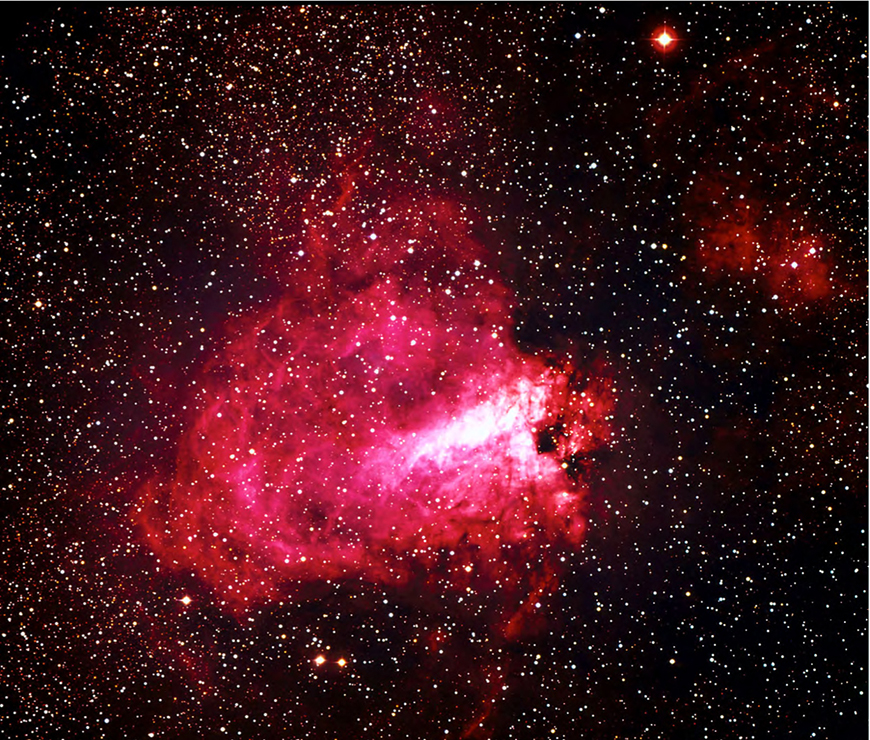
The Omega Nebula. Image Credit: ESO. Creative Commons.
While not as extensive as the Orion Nebula, M42, M17 has a brightly condensed core and as such is arguably the second most prominent emission nebula in the sky. A telescope will reveal the looped structure of the gas clouds against which are silhouetted dark clouds of material, which causes the distinctly swan like shape. The looped area of the “neck” of the Swan is what gave rise to the Omega and Horseshoe nicknames - as this section does resemble the Greek letter, or indeed the shoe of a horse. The Lobster nickname comes from the tail-like section of the nebula - the opposing end to the swan’s neck - and the red-pink colour of the nebula revealed in long duration astrophotography. The glowing gas clouds of this nebula are powered by newly-formed stars hiding in its interior. These massive stars can’t be seen optically, but studies of the nebula at other wavelengths have revealed their presence. These stars are big and extremely luminous - it is estimated they are anything up to 30 times the mass of the Sun and 6 times hotter. It is estimated there is enough material left in the Omega Nebula to form up to 800 stars the mass of the Sun - a much higher number than that the Orion Nebula is capable of producing.
M17 is thought to lie around 5-6000 light years from us.
Leaving Sagittarius, we briefly cross over its northern border into the constellation of Serpens Cauda - the tail of Serpens. Just under 2 1/2 degrees to the north of M17 sits a magnificent 35 x 28 arc minute target: this object is the +6.40 mag star cluster and nebula, M16 – otherwise known as the Eagle Nebula. Made famous by the famous “Pillars of Creation” Hubble Space Telescope picture, this object is well seen in all kinds of telescope, but the larger the instrument, naturally, the more you can see of it! The star cluster formed from the surrounding nebulosity, which can be glimpsed in a sub-6-inch telescope. An instrument of the class of a 12-inch+ Dobsonian will be needed to see the “Pillars” and OIII or UHC-type filter will help considerably with this. Photographically, the Eagle Nebula is a fantastic subject. Amateur CCD images of the nebula may lack the resolution of the Hubble image, but can reveal a surprising amount of equivalent detail.
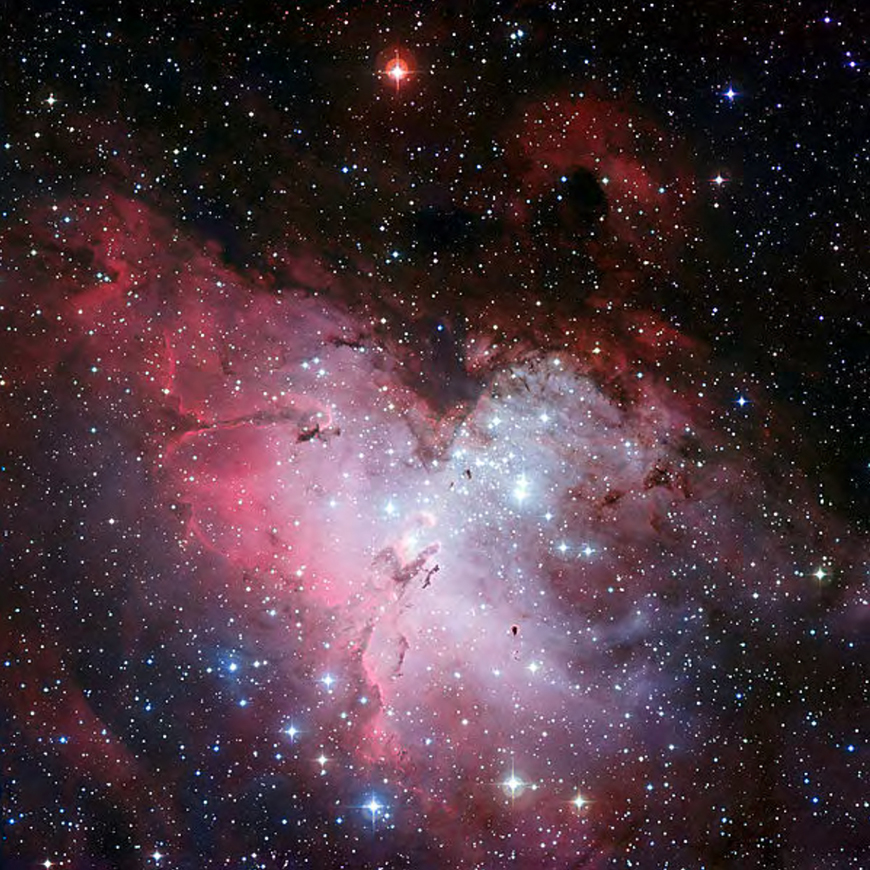
The Eagle Nebula. Image Credit: ESO. Creative Commons.
The Eagle was discovered by de Cheseaux in 1745 or 46 - though he simply listed the star cluster as the point of focus. Messier, independently recovering it nearly 20 years later in 1764, not only mentions the star cluster, but also the impression that the stars within it we “enmeshed in a faint glow” - a clear sign that nebulosity was evident to him in his observations. Certainly the nebulous regions of M16 start to be visible in a telescope of around 8-inches of aperture, but as previously mentioned, 12-inches of aperture will be needed to start making out structure within the nebula itself.
Modern astrometry puts the Eagle at about 7000 light years from our neck of the cosmic woods - similar in distance to the aforementioned Omega Nebula. Some theorists postulate that the two objects may be linked by the same molecular cloud and form two parts of a constituent whole. Certainly, there can be little doubt that they both lie in the same part of our galaxy - the Sagittarius-Carina spiral arm, but re they more closely related?
The age of the stars in the cluster seem to suggest that the M16’s stellar population itself is around 5.5 million years old. Some astronomers have pointed out that while the “Pillars of Creation” area of the Eagle Nebula is prominent from our perspective today, that stellar compression by cosmic wind and the sheer luminance of the newly formed stars has probably already eroded these completely - in 7000 years-or-so, we’ll find out if this is actually true!
Moving NE of the Omega Nebula complex, we come to the diminutive constellation of Scutum, The Shield. Scutum contains two objects of note, both open star clusters, the fainter M26 and the magnificent M11, or Wild Duck Cluster. M26 is 9 degrees NE of the Omega Nebula and at +8.00 mag and 7 arc minutes in diameter is not the brightest, nor largest cluster in the area. This is largely thought to be the result of interstellar matter obscuring part of the cluster - a reasonable common occurrence for objects located on or near the plane of our galaxy. If this material was not present it is likely M26 would appear much bigger and brighter than it does to us. Binoculars will pick it out and small telescopes will show its 30-or-so members well. Messier found M26 on the night of 20th June 1764 and reportedly was rather underwhelmed by its appearance - “not distinguished in a 3 1.2 foot [focal length] telescope and needed a better instrument”, he wrote in his description.
M26 is thought to lie around 5000 light years away.
M26’s neighbour, M11 is to be found just under 3.5 degrees to the NE. Whereas M26 is rather diminutive, the Wild Duck Cluster, as it is commonly known, is a lovely, rich object of +5.80 mag and 32 arc minutes across. The major part of the cluster takes up an area roughly a third of the diameter of the Moon, making it a prominent feature in this area of sky. M11 was discovered in 1681 by German Astronomer Gottfried Kirsch and included as an original Messier object in 1764. It was the noted observer Admiral Smyth who first suggested the “Wild Duck” moniker - describing the fan shaped structure as resembling “a flight of
wild ducks”. If examined in a telescope or larger binoculars, the “V” shape of the cluster seems to point in an Easterly direction, though it is not particularly well defined. M11 is supposed to be about 250 million years old and thought to be around 6000 light years distance. Its total of stars is thought to number just shy of 3000, though only 500 of which will be visible to amateur telescopes. It is not an object that should be missed in any type of instrument.
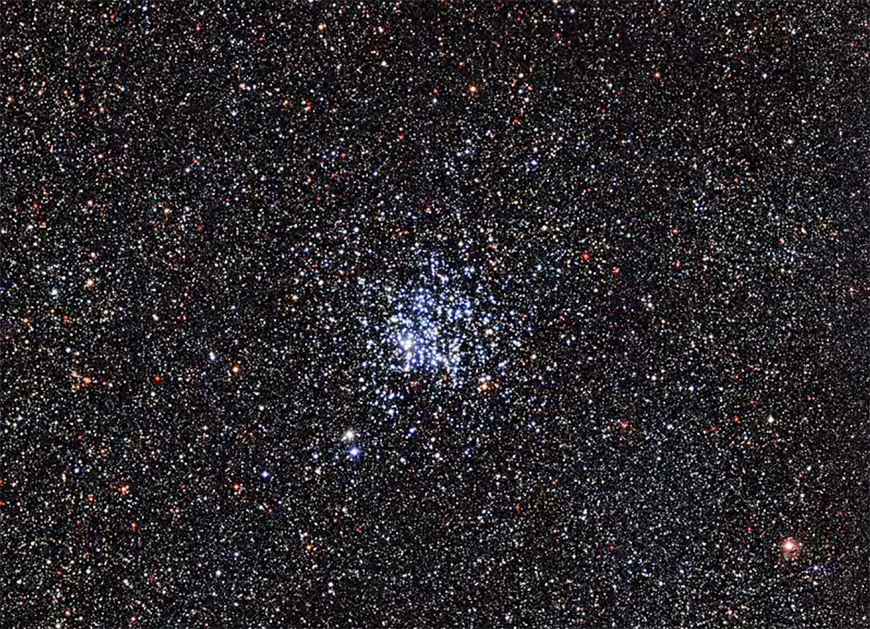
The Wild Duck Cluster. Image Credit: ESO. Creative Commons.
Original text: Kerin Smith

 English
English
